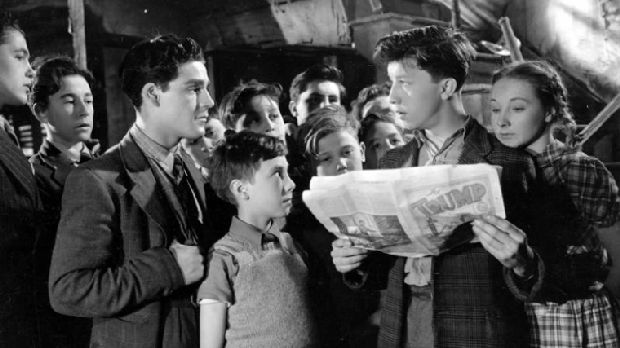Hue and Cry (1947) 

Director: Charles Crichton
Cast: Alastair Sim, Frederick Piper, Harry Fowler
Synopsis: A gang of street boys foil a master crook who sends commands for robberies by cunningly altering a comic strip’s wording each week, unknown to writer and printer.
What a playground the bomb-blasted post-war streets of London must have been for young kids back in the 1940s. The plentiful mountains of rubble that once housed the City’s working class must have provided them with hours of fun in an age when health and safety was all about putting filters on your roll-ups and wearing bicycle clips when you gave your mate a coggy. One of the many strengths of Hue and Cry is its backdrop of these ruined city streets – it’s also perhaps typical of the British film industry of the time that it would set a breezy comedy like this against such a backdrop; compare, for example, Italy’s use of a similar landscape for the purposes of social commentary in Germany, Year Zero (1948) and America’s as the location for an espionage action thriller in Berlin Express (1948). Whereas these latter two movies made the war-torn state of their locations the prime factor in their story, in Hue and Cry it is nothing more than a children’s playground to which no particular attention is paid.
The film initially appears to be about a cheeky looking young Scottish lad who is caught by his choir master surreptitiously reading the latest copy of The Trump, instead of singing from the same hymn sheet as his fellow choirboys. The lad’s teacher sniffily throws the offending comic out of the window, where it comes to the attention of some older boys, one of whom is Joe Kirby (Harry Fowler). After reading a few paragraphs of a story in the comic and discovering the following page is missing, Joe professes disinterest in how the story ends, but the next day he furtively buys his own copy of The Trump (a word which today has a slang meaning I’m sure couldn’t have been known to writer T. E. B. Clarke in 1947) and reads it on a bus ride into London, where he’s looking for work.
As he’s walking the streets reading his comic, Joe’s path crosses those of two men carrying a large crate just like the one described in the story he’s reading. What’s more, the truck from which it’s unloaded has the same registration as the one in the comic! Smelling something fishy, Joe has his friend who works nearby throw a stone through the window of the shop into which the crate was taken to entice the proprietor outside. Sure enough, the shop owner chases after Joe’s mate, leaving the shop unattended, and allowing Joe to investigate the contents of the crate. However, the shop owner returns while Joe is rooting through the crate, which contains fur coats, and locks him in a back room while he calls the police.
Naturally, the police detective is highly sceptical of Joe’s story about the van’s registration appearing in the comic he was reading, but when the shop owner declines to press charges after learning that doing so would mean immediately leaving his shop, the detective takes pity on Joe and gives him the name of a friend who will give him a job. That friend is none other than Jack Warner. No, not the head of Warner Brothers Studios, but the lovable British music hall performer turned actor who would be welcomed into the nation’s front rooms for decades as PC Dixon, the world’s only resurrected copper, in Dixon of Dock Green. Warner plays against type as a spivvy sort of character which, given the familiarity of his later screen persona, never really rings true.
Anyway, the police detective’s dismissive attitude isn’t enough to dissuade Joe from conducting his own investigation with the aid of his friends, who have a headquarters amongst those bombed out ruins I told you about earlier. This gang, collectively credited as the ‘Blood and Thunder Boys,’ range in age from about eight to eighteen (although one of them, John Hudson, was 28 when the movie was made) and its members are as resourceful as they are boisterous. With the help of a young lad who works at the office where the comic is printed, the gang learn the identity of the story’s writer – one Felix H. Wilkinson (Alastair Sim) – and, after visiting him — get wind of the fact that details he puts in his stories are being changed by someone else before they’re published in The Trump. Their investigations then lead them to a young woman (Valerie White) who works at the office who, it appears, has been intercepting Wilkinson’s stories before they reach the publisher…
Hue and Cry was the first of Ealing’s famous comedies, but already most of the elements with which we associate Ealing comedies are present and correct. The story has a light and exuberant breeziness that keeps the plot racing along with barely a pause for breath while never feeling forced or contrived. Even after more than sixty years, some of the comedy still holds up remarkably well (that stricken speak-your-weight machine, for example), although it remains firmly a product of its time, meaning it will have little appeal to anyone who either wasn’t around when the movie was made or didn’t grow up watching them on TV in the 1960s and ’70s. I mean, let’s face it, most of the kids here wear suits and ties…
(Reviewed 20th November 2013)
httpv://www.youtube.com/watch?v=xJxbaymZ7K0
